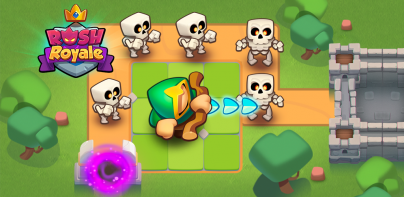


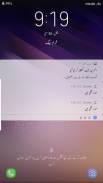
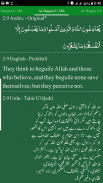

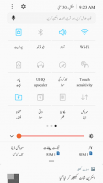
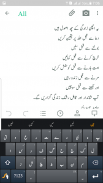



Jameel Noori Nastaleeq FlipFont

Jameel Noori Nastaleeq FlipFont介绍
Nastaʿlīq (Persian: نستعلیق, from نسخ Naskh and تعلیق Taʿlīq) is one of the main calligraphic hands used in writing the Persian script, and traditionally the predominant style in Persian calligraphy.[1] It was developed in Iran in the 14th and 15th centuries.[2] It is sometimes used to write Arabic-language text (where it is known as Taʿliq[citation needed] or Persian and is mainly used for titles and headings), but its use has always been more popular in the Persian, Turkic and Urdu sphere of influence. Nastaʿlīq has extensively been (and still is) practised in Iran, Pakistan, India, Afghanistan and other countries for written poetry and as a form of art.
A less elaborate version of Nastaʿlīq serves as the preferred style for writing in Kashmiri, Punjabi and Urdu, and it is often used alongside Naskh for Pashto. In Persian it is used for poetry only. Nastaʿlīq was historically used for writing Ottoman Turkish, where it was known as tâlik[3] (not to be confused with a totally different Persian style, also called taʿlīq; to distinguish the two, Ottomans referred to the latter as taʿlīq-i qadim, "old taʿlīq").
Nastaʿlīq is the core script of the post-Sassanid Persian writing tradition, and is equally important in the areas under its cultural influence. The languages of Iran (Western Persian, Azeri, Balochi, Kurdi, Luri, etc.), Afghanistan (Dari, Pashto, Uzbek, Turkmen, etc.), Pakistan (Punjabi, Urdu, Kashmiri, Saraiki, etc.), and the Turkic Uyghur language of the Chinese province of Xinjiang, rely on Nastaʿlīq. Under the name taʿliq (lit. “suspending [script]”), it was also beloved by Ottoman calligraphers who developed the Diwani (divanî) and Ruqah (rık’a) styles from it.
Nastaʿlīq is amongst the most fluid calligraphy styles for the Arabic alphabet. It has short verticals with no serifs, and long horizontal strokes. It is written using a piece of trimmed reed with a tip of 5–10 mm (0.2–0.4 in), called qalam ("pen", in Arabic and Persian قلم), and carbon ink, named davat. The nib of a qalam can be split in the middle to facilitate ink absorption.
Two important forms of Nastaʿlīq panels are Chalipa and Siah-Mashq. A Chalipa ("cross", in Persian) panel usually consists of four diagonal hemistiches (half-lines) of poetry, clearly signifying a moral, ethical or poetic concept. Siah-Mashq ("black drill") panels, however, communicate via composition and form, rather than content. In Siah-Mashq, repeating a few letters or words (sometimes even one) virtually inks the whole panel. The content is thus of less significance and not clearly accessible.
For more detail:https://en.wikipedia.org/wiki/Nasta%CA%BFl%C4%ABq_script
波斯体(波斯语:نستعلیق,从نسخ纳斯赫和تعلیقTa'līq)是在写剧本的波斯使用的主要书法的一只手,并在传统的波斯书法的主要样式[1]这是在伊朗开发的,在14和15世纪。[2]它有时被用来写阿拉伯语文本(其中它被称为Ta'liq [来源请求]或波斯和主要用于标题和标题),但在波斯,突厥语和乌尔都语领域它的使用一直比较流行影响。波斯体已经广泛地被(现在仍然是)在伊朗,巴基斯坦,印度,阿富汗和其他国家的书面诗歌和艺术的形式实施。
波斯体的不太精细的版本作为在克什米尔,旁遮普语和乌尔都语写的首选风格,它常常被一起纳斯赫的普什图语。在波斯它仅用于诗歌。波斯体在历史上用于写入奥斯曼土耳其,在那里它被称为tâlik[3](不要与一个完全不同的波斯风格,也称为ta'līq混淆;区分两种,脚垫称为后者作为ta'līq-i的qadim, “老ta'līq”)。
波斯体是后萨珊波斯写作传统的核心脚本,并在其文化影响下的地区同样重要。伊朗的语言(西方波斯,阿塞拜疆,俾路支,库尔迪,Luri等),阿富汗(达里语,普什图语,乌兹别克,土库曼等),巴基斯坦(旁遮普语,乌尔都语,克什米尔,Saraiki等),以及中国的省新疆的突厥维吾尔语,依靠波斯体。在名称ta'liq(点亮“暂停[脚本]”),它也是由谁开发Diwani(迪瓦尼)和Ruqah(rık'a)从它的风格奥斯曼书法家钟爱。
波斯体是其中最流体书法风格的阿拉伯字母。它有没有衬线短垂直和水平长行程。它使用的是一块修整簧片以5-10毫米(0.2-0.4英寸)的写尖端,称为qalam(“笔”,在阿拉伯语和波斯语قلم)和碳墨,命名davat。一个qalam的笔尖可以在中间被分割,以促进墨水的吸收。
波斯体面板的两种重要形式是Chalipa和SIAH-Mashq。甲Chalipa(“交叉”,波斯语)面板通常包括诗四个对角线hemistiches(半直线),明确标志着一个道德,伦理或诗概念。 SIAH-Mashq(“黑钻”)面板,但是,通过组合物和形式进行通信,而不是内容。在SIAH-Mashq,重复一些字母或单词(有时甚至一个)几乎油墨整个面板。内容是这样的不那么重要,并没有明确的访问。
欲了解更多详情:HTTPS://en.wikipedia.org/wiki/Nasta%CA%BFl%C4%ABq_script















